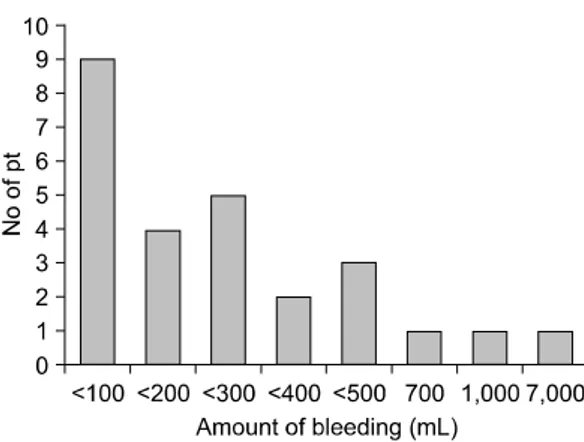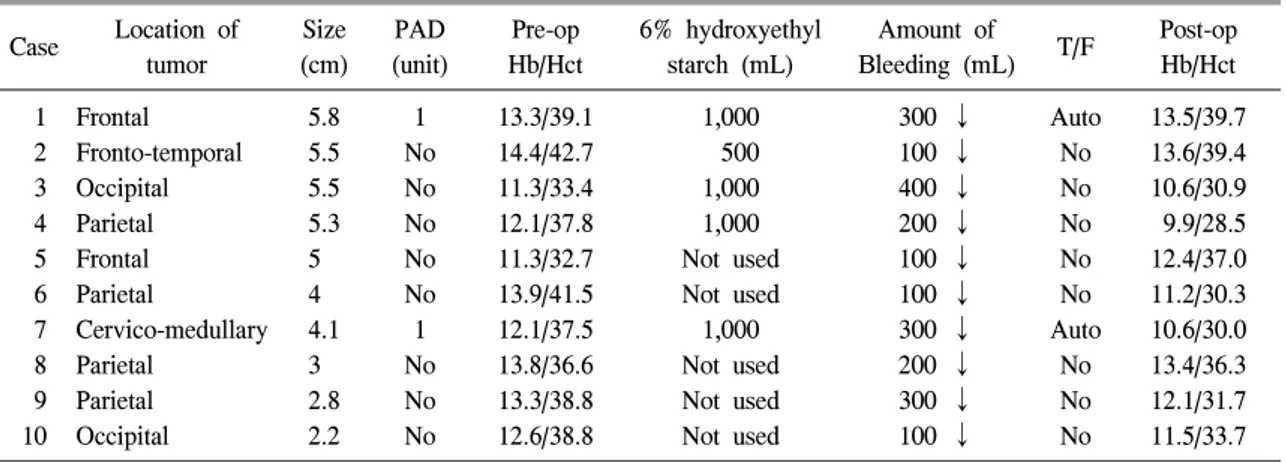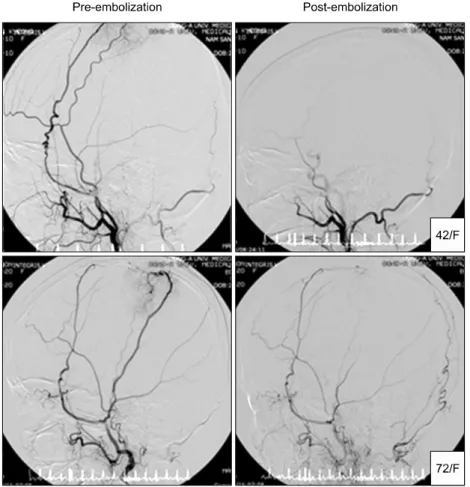접수일:2010년 4월 12일, 수정일:2010년 4월 15일, 승인일:2010년 4월 19일
책임저자:김 경 희 602-715 부산시 서구 동대신동 3가 1번지 동아대학교 의과대학 진단검사의학교실
뇌종양 수술에서 자가수혈과 혈액 관리의 경험
김기욱ㆍ송영진ㆍ오성용1ㆍ이종환2ㆍ김경희3
동아대학교 의과대학 신경외과학교실, 내과학교실1, 마취통증의학교실2, 진단검사의학교실3
= Abstract =
An Experience of Autologous Blood Transfusion and Blood Management in Brain Tumor Surgery
Ki-Uk Kim, Young-Jin Song, Sung Yong Oh1, Jong-Hwan Lee2, Kyeong-Hee Kim3
Departments of Neurosurgery, Internal Medicine1, Anesthesiology and Pain Medicine2 and Laboratory Medicine3, Dong-A University College of Medicine, Busan, Korea
Background: Allogeneic blood transfusion has risks from transfusion-transmitted pathogens. Blood management programs are widely used for cardiovascular or orthopedic surgery, but there have been few studies that have focused on blood conservation during brain tumor resection surgery. The purpose of this study was to evaluate the benefits of blood management for brain tumor surgery.
Methods: A total of 26 patients undergoing brain tumor resection surgery were included in the study. Thirteen patients with meningiomas, 10 patients with malignant gliomas and 3 patients with other tumors were included.
The surgical blood loss was estimated by preoperative imaging studies, and the tumors that could be operated with minimal bleeding were excluded. Preoperative autologous donation (PAD) was done when the expected amount of surgical bleeding surpassed 300 mL. Preoperative embolization was performed in the patients with meningiomas whenever it was technically feasible. Six percent hydroxyethyl starch 130/0.4 (Voluven) was administered during anesthesia for expanding the blood volume and we performed meticulous surgical techniques for minimizing the blood loss.
Results: The amount of bleeding was less than 300 mL in 69.2% of the patients. Preoperative autologous blood was donated by 10 patents and 20% of the PAD units were discarded. Five patients with meningimas received preoperative embolization. None of the patients, except for one patient who had massive bleeding of 7,000 mL, were transfused allogeneic blood. Eighty one percent of the patients received Voluven without complications.
Conclusion: Multiple strategies that include preoperative embolization, proper surgical techniques for minimizing blood loss, PAD and hydroxyehtyl starch could effectively decrease the amount of allogenic blood transfused during brain tumor resection surgery. (Korean J Blood Transfus 2010;21:58-64)
Key words: Preoperative autologous donation, Blood management, Brain tumor surgery, 6% hydroxyethyl starch
서 론
동종 적혈구의 수혈은 수혈 전파성 감염의 위 험과 함께 용혈성 수혈 부작용, 발열성 수혈 부 작용, 급성 폐손상 등과 같은 부작용이 따르게 된다.1,2) 혈액관리(blood management)는 단순히 종교적 신념 등의 이유로 수혈 받는 것을 거부 하는 무수혈의학(bloodless medicine)과 구별되는 새로운 개념으로 교차시험 대 수혈의 비를 모니 터링 하거나 수술 전 빈혈의 관리를 위한 센터를 개소하는 등 광범위하게 혈액의 사용을 관리하 는 것이다. 혈액의 부적절한 사용을 예방하고 혈 액 사용의 이익을 극대화함으로써 궁극적으로 환자의 예후를 좋게 하고 의료비의 지출을 줄이 는 등 다양한 장점을 가지고 있는 새로운 영역이 다.3)
혈액관리 프로그램들은 주로 심혈관계 혹은 정 형외과 수술 영역에서 널리 이용되고 있으며 뇌 종양 절제 수술에서의 혈액 관리에 대한 보고는 드물다.4,5) 저자들은 동종 적혈구의 수혈을 최소 화하고 여러 가지의 혈액 관리 프로그램을 이용 하여 뇌종양 절제 수술을 시행하였던 경험을 보 고하고자 한다.
대상 및 방법
1. 대상
동아대학교의료원에서 뇌종양 절제 수술을 시 행 받은 총 26명의 환자를 대상으로 하였다. 13명 은 수막종, 10명은 악성 교양종이었으며 3명은 기타 종양이었다. 평균 나이는 56.9세(범위 13∼
77) 이었으며 남성은 8명, 여성은 18명이었다.
2. 수술 전 자가 혈액 예치(Preoperative autologous donation, PAD)
수술 중에 예상 되는 혈액 소실량은 수술 전에 시행한 영상의학적 소견에 의해 평가 되었으며, 수술 중에 최소의 실혈이 예상되는 종양의 경우 는 본 연구에서 제외하였다. 수술 전 자가 혈액 예치는 실혈의 양이 300 mL을 초과할 것으로 예 측될 경우에 시행하였으며, 수술 72시간 이전에 전혈 320 mL 1단위 혹은 2단위를 준비하였다. 수 술 전의 혈색소 수치는 최종 자가 혈액 예치가 이 루어진 후에 측정되었으며, 수술 후 혈색소 수치 측정은 수술을 마치고 나서 신경계 중환자실에 입실하여 이루어졌다.
3. 수술 전 색전술(Preoperative embolization) 수술 전에 색전술이 가능한 수막종 환자의 경 우에는 색전술을 시행하여 수술 중에 출혈의 양 을 줄이고자 하였다.
4. 6% hydroxyethyl starch (Voluven) 사용
마취 중에는 순환혈액량 감소를 예방하기 위해 6% hydroxyethyl statch (Voluven)을 사용하였다.
5. 최소 출혈을 위한 수술적 테크닉 이용
수술 중에는 세심한 출혈 관리를 통해 실혈의 양을 최소화하도록 하였다.
6. 수술 중 출혈량 계산
수술 중 출혈의 양은 세척액을 일정하게 사용 하게 하여 흡인기의 총 혈액량을 측정하여 계산 하였다. 또한 수술 중에 4×4 거즈가 충분히 혈액 으로 적셔진 경우에는 8 mL, 2×2 거즈인 경우에 는 2 mL의 혈액이 출혈된 것으로 환산하여 수술 후에 출혈량을 산출하였고, 거즈는 혈액으로 충
Fig. 1. Distribution of amount of bleeding in 26 patients undergoing brain tumor resection surgery.
Table 1. Summary of 13 meningioma patients
Case Location of tumor
Size (cm)
Pre-op embolization
PAD (unit)
Pre-op Hb/Hct
6% hydroxyethyl starch (mL)
Amount of
bleeding (mL) T/F Post-op Hb/Hct
1 Convexity 6.1 Yes 1 14.7/43.4 1,000 300 ↓ Auto 10.9/31.6
2 Convexity 5 Yes 1 13.1/39.0 1,000 200 ↓ No 11.5/31.3
3 Convexity 3.7 Yes No 13.2/38.1 1,000 100 ↓ No 10.6/31.4
4 Parasagittal 5.2 Yes 1 13.3/39.1 1,000 200 ↓ No 11.4/32.3
5 Parasagittal 5.1 Yes No 12.6/38.6 1,500 1,000 No 7.4/22.1
6 Convexity 4.6 No No 13.7/41.5 1,000 100 ↓ No 10.4/29.6
7 Convexity 4.1 No No 12.7/38.0 1,000 100 ↓ No 9.8/27.9
8 Convexity 5 No No 17.0/48.0 1,000 100 ↓ No 13.4/39.7
9 Parasagittal 4.9 No 1 12.2/36.3 500 300 ↓ Auto 11.7/32.2
10 Parasagittal 3.6 No No 10.3/31.7 1,000 100 ↓ No 11.8/33.2
11 Falx 5.8 No 2 13.1/35.8 1,000 7,000 Auto+Allo 11.5/31.9
12 Cavernous sinus
5 No 1 13.0/38.5 1,000 500 ↓ Auto 11.8/32.6
13 Foramnen magnum
2.6 No No 14.9/41.6 1,000 400 ↓ No 13.6/39.8
Abbreviations: PAD, preoperative autologous donation; T/F, transfusion.
분히 젖은 후에 새로운 거즈를 사용하였다.
결 과
1. 출혈량의 분포
최소 출혈을 위한 수술적 테크닉을 이용하여 18명(69.2%)의 환자에서 300 mL 이하의 출혈을 보였으나, 수막종 환자 1명은 7,000 mL의 대량 출 혈을 보였다(Fig. 1).
2. 수술 전 자가혈액 예치
수술 전 자가혈액 예치는 총 10명(38.5%)에서 시행되었으며 그 중에서 7명은 예치되었던 자가 혈액만을 사용하여 동종 적혈구의 사용을 피할 수 있었다. 그러나 자가혈액을 예치하였으나 대 량 출혈을 보였던 환자는 예치된 자가혈액 2단위 를 수혈 받은 후에 동종 적혈구 3단위, 동종 신선
동결혈장 2단위를 추가적으로 수혈 받았다. 2명 은 출혈량이 적어 예치된 자가혈액을 사용하지 않았고, 이 혈액들은 폐기가 되었다(Table 1∼3).
Table 2. Summary of 10 malignant glioma patients
Case Location of tumor
Size (cm)
PAD (unit)
Pre-op Hb/Hct
6% hydroxyethyl starch (mL)
Amount of
Bleeding (mL) T/F Post-op Hb/Hct
1 Frontal 5.8 1 13.3/39.1 1,000 300 ↓ Auto 13.5/39.7
2 Fronto-temporal 5.5 No 14.4/42.7 500 100 ↓ No 13.6/39.4
3 Occipital 5.5 No 11.3/33.4 1,000 400 ↓ No 10.6/30.9
4 Parietal 5.3 No 12.1/37.8 1,000 200 ↓ No 9.9/28.5
5 Frontal 5 No 11.3/32.7 Not used 100 ↓ No 12.4/37.0
6 Parietal 4 No 13.9/41.5 Not used 100 ↓ No 11.2/30.3
7 Cervico-medullary 4.1 1 12.1/37.5 1,000 300 ↓ Auto 10.6/30.0
8 Parietal 3 No 13.8/36.6 Not used 200 ↓ No 13.4/36.3
9 Parietal 2.8 No 13.3/38.8 Not used 300 ↓ No 12.1/31.7
10 Occipital 2.2 No 12.6/38.8 Not used 100 ↓ No 11.5/33.7
Abbreviations: See Table 1.
Table 3. Summary of 3 other brain tumor patients
Case Diagnosis Size (cm) PAD Pre-op Hb/Hct
6% hydroxyethyl starch (mL)
Amount of
Bleeding (mL) T/F Post-op Hb/Hct
1 Acoustic schwannoma 4.6 2 15.1/44.3 1,000 700 Auto 13.1/36.2
2 Craniopharyngioma 6.5 1 13.5/40.4 500 500 ↓ Auto 12.9/37.1
3 Germ cell tumor 4.2 No 12.0/31.9 500 500 ↓ No 12.5/38.5
Abbreviations: See Table 1.
3. 수술 전 색전술
총 13명의 수막종 환자 중에서 5명(38.5%)에서 색전술이 시행되었으며, 색전술 시행과 함께 자 가혈액을 예치하였던 3명 중 2명은 예치된 혈액 을 사용하지 않고 폐기하였다(Fig. 2, Table 1).
4. 6% hydroxyethyl starch (Voluven) 사용
수막종 환자 13명에서는 모두 Voluven이 사용 되어졌으며, 악성 교양종 환자에서는 5명(50%)에 서 사용되어졌다. 기타 종양 환자 3명에서도 모 두 Voluven을 사용하였다. 사용한 모든 환자(21 명, 81%)에서 Voluven 사용과 관련된 합병증은 관찰되지 않았다(Table 1∼3).
고 찰
다양한 외과적인 수술에서 동종 적혈구의 수혈 은 필요하지만, 수혈 전파성 감염을 비롯하여 용 혈성 수혈 부작용, 발열성 수혈 부작용, 급성 폐 손상, 동종 면역의 발생과 같은 위험이 따르기 때 문에 동종 적혈구의 수혈을 줄이기 위한 다양한 노력들이 있어 왔다.1,2) 최근에는 단순히 무수혈 수술이라는 개념을 넘어서서 여러 가지 적극적인 시도들이 있다.6) 먼저 인식과 행동의 변화를 가 져오도록 하기 위해 심폐계 질환이 없는 경우 혈 색소 7.0 g/dL, 심장이나 폐의 질환이 있는 경우 혈색소 10.0 g/dL의 기준으로 수혈을 시작하도록 하는 evidence-based transfusion trigger를 사용하도
Fig. 2. Examples of com- parison of vasculature be- tween preoperative emboli- zation and postembolization state in meningioma patients.
록 하고 있다.7) 또한 수술 전에 빈혈이 있으면 철 분 제제나 erythropoietin으로 치료를 하여 수술 중 수혈의 가능성을 낮추고자 한다.8,9)
Perioperative autotransfusion 프로그램에는 여러 가지들이 있으며 일반적으로 한 가지 테크닉을 사용하는 것은 여러 가지 기법을 동원하는 것만 큼 효과적이지 않기 때문에 수술 중에 혈액 소실 을 줄이고자 하는 여러 기술들과 기구들이 개발 되어 있다. 동종 적혈구 수혈을 감소 시키기 위한 대표적인 방법이 수술 전 자가 혈액 예치(preo- perative autologous donation, PAD)이다. 본 연구에 서도 시행이 되었지만 실제 수술에서의 출혈의
양을 정확히 예측하기 어려운 점이 있어 PAD의 약 절반 가량이 폐기된다는 보고도 있다.10) 본 연 구에서는 수술 전 색전술을 시행한 수막종 환자 2명에서 자가 예치된 혈액이 폐기되어 20%의 빈 도를 보였다. PAD는 적절한 조건에서 환자의 빈 혈과 조혈 상태를 모니터링하면서 실시해야 효과 적이라는 최근 연구가 있어, 향후 PAD의 이용에 대한 적절한 지침이 필요할 것으로 보인다.11) 수술 중에 사용할 수 있는 방법으로는 수술 중 에 출혈되어 나온 혈액을 수집하고 정화시켜 재 주입하는 혈액회수(blood recovery)와 수술 직전 에 전혈을 채혈해 두고 수술 중에는 적혈구가 적
게 포함된 혈액이 소실 되도록 하는 급성 정상 혈 액량 혈액희석법(acute normovolemic hemodilution, ANH)이 있다.12,13) 본 연구에서는 혈액 회수 방법 이나 ANH는 사용하지 않았지만 수술 중에 혈액 량을 유지하기 위해 6% hydroxyethyl starch 130/
0.4 (Voluven)을 사용하였다. Voluven은 인간 기원 이 아닌 콜로이드액으로 순환혈액량의 감소를 예 방할 목적으로 사용된다. 관상동맥 수술을 비롯 한 주요수술에서 안전하게 이용될 수 있는 것으 로 되어 있으며, 본 연구에서와 같이 뇌종양 제거 수술에서도 부작용 없이 이용되어 동종 적혈구의 수혈을 감소하는 데 도움이 되었다.14,15)
수막종에서는 수술전 색전술을 시행하여 수술 중 출혈량을 감소시키고, 동종 적혈구의 수혈을 줄이는 효과를 얻을 수 있다.16,17) 본 연구에서도 38.5%의 수막종 환자에서 색전술이 시행되었으 며, 색전술이 시행된 모든 환자에서 동종 적혈구 의 수혈은 피할 수 있었다.
혈액관리는 수혈에 대한 인식의 전환, 다양한 응고기능 개선 약물의 개발, 외과적인 기술, 기구 의 발전, apheresis 기계의 발전 등 여러 분야의 통 합적인 노력에 의해 이루어 질 수 있다.3) 헌혈 인 구의 감소로 인한 혈액 부족의 시대에 여러 영역 의 통합적인 노력에 의한 혈액 관리의 중요성은 더욱 부각될 것으로 보인다.18) 본 연구에서는 수 술 전 자가혈액 예치, 수술 전 색전술, 6% hydro- xyethyl starch (Voluven)의 사용, 최소 출혈을 위한 수술적 테크닉 이용의 통합적인 노력을 통해 뇌 종양 제거 수술에서 동종 적혈구의 수혈을 최소 화하였다.
요 약
배경: 동종 적혈구의 수혈은 수혈 전파성 감염 의 위험이 있다. 혈액관리 프로그램들은 주로 심
혈관계 혹은 정형외과 수술 영역에서 널리 이용 되고 있으며 뇌종양 절제 수술에서의 혈액 관리 에 대한 보고는 드물다. 혈액 관리 프로그램을 이 용하여 동종 적혈구의 수혈을 최소화하고 뇌종 양 절제 수술을 시행하였던 경험을 보고하고자 한다.
방법: 동아대학교의료원에서 뇌종양 절제 수 술을 시행 받은 총 26명의 환자를 대상으로 하였 다. 수술 중에 예상 되는 혈액 소실량은 수술 전 에 시행한 영상학적 소견에 의해 평가 되었으며, 수술 중에 최소의 실혈이 예상되는 종양의 경우 는 본 연구에서 제외하였다. 수술 전 자가 혈액 예치는 실혈의 양이 300 mL을 초과할 것으로 예 측될 경우에 시행하였다. 수술 전에 색전술이 가 능한 수막종 환자의 경우에는 색전술을 시행하 였다. 마취 중에는 순환혈액량 감소를 예방하기 위해 6% hydroxyethyl statch (Voluven)을 사용하 였고, 최소 출혈을 위한 수술적 테크닉을 이용 하였다.
결과: 13명의 수막종, 10명의 악성 교양종, 3명 의 기타 종양이 포함되었다. 18명(69.2%)의 환자 에서 300 mL 이하의 출혈을 보였다. 수술 전 자 가혈액 예치는 총 10명(38.5%)에서 시행되었으며 2명의 예치된 자가혈액을 사용되지 않아 폐기가 되었다. 7,000 mL의 대량 출혈을 보인 수막종 환 자 1명을 제외하고는 동종 적혈구의 수혈은 피할 수 있었다. 21명(81%)에서 Voluven이 사용되었으 며 합병증은 관찰되지 않았다.
결론: 수술 전 자가혈액 예치, 수술 전 색전술, 6% hydroxyethyl starch (Voluven)의 사용, 최소 출 혈을 위한 수술적 테크닉 이용의 통합적인 노력 을 통해 뇌종양 제거 수술에서 동종 적혈구의 수 혈을 최소화하였다.
참고문헌
1. Jayaraman S, Chalabi Z, Perel P, Guerriero C, Roberts I. The risk of transfusion-transmitted infections in sub-Saharan Africa. Transfusion 2010;50:433-42
2. Mazzei CA, Popovsky MA, Kopko PM. No- ninfectious Complications of Blood transfusio n.Technical manual. 16th ed. Bethesda, Mary- land: American Association of blood Banks, 2008:715-49
3. Waters JH, Blood management. Technical ma- nual. 16th ed. Bethesda, Maryland: American Association of blood Banks, 2008:665-75 4. Rashiq S, Jamieson-Lega K, Komarinski C,
Nahirniak S, Zinyk L, Finegan B. Allogeneic blood transfusion reduction by risk-based pro- tocol in total joint arthroplasty. Can J Anaesth 2010;57:343-9
5. Sinclair KC, Clarke HD, Noble BN. Blood ma- nagement in total knee arthroplasty: a com- parison of techniques. Orthopedics 2009;32:19 6. Samolyk KA. State-of-the-art blood manage-
ment in cardiac surgery. Semin Cardiothorac Vasc Anesth 2009;13:118-21
7. Practice guidelines for blood component the- rapy: a report by the American society of anesthesiologists task force on blood com- ponent therapy. Anesthesiology 1996;84:732-47 8. Bohlius J, Wilson J, Seidenfeld J, Piper M,
Schwarzer G, Sandercock J, et al. Recombinant human erythropoietins and cancer patients:
updated meta-analysis of 57 studies including 9353 patients. J Natl Cancer Inst 2006;98:708-14 9. Michael B, Fishbane S, Coyne DW, Agarwal R,
Warnock DG. Drug insight: Safety of intrave- nous iron supplementation with sodium ferric gluconate complex. Nat Clin Pract Nephrol
2006;2:92-100
10. Brecher ME, Goodnough LT. The rise and fall of preoperative autologous blood donation.
Transfusion 2001;41:1459-62
11. Singbartl G, Schreiber J, Singbartl K. Preopera- tive autologous blood donation versus intra- operative blood salvage: intraindividual ana- lyses and modeling of efficacy in 1103 pa- tients. Transfusion 2009;49:2374-83
12. Waters JR, Meier HH, Waters JH. An econo- mic analysis of costs associated with develop- ment of a cell salvage program. Anesth Analg 2007;104:869-75
13. Feldman JM, Roth JV, Bjoraker DG. Maximum blood savings by acute normovolemic hemodi- lution. Anesth Analg 1995;80:108-13
14. Ooi JS, Ramzisham AR, Zamrin MD. Is 6%
hydroxyethyl starch 130/0.4 safe in coronary artery bypass graft surgery? Asian Cardiovasc Thorac Ann 2009;17:368-72
15. Kozek-Langenecker SA, Jungheinrich C, Sauer- mann W, Van der Linden P. The effects of hydroxyethyl starch 130/0.4 (6%) on blood loss and use of blood products in major sur- gery: a pooled analysis of randomized clinical trials. Anesth Analg 2008;107:382-90
16. Rosen CL. Meningiomas: the role of preopera- tive angiography and embolization. Neurosurg Focus 2003;15:E10
17. Yoon YS, Ahn JY, Chang JH, Cho JH, Suh SH, Lee BH, et al. Pre-operative embolisation of internal carotid artery branches and pial ve- ssels in hypervascular brain tumours. Acta Neurochir (Wien) 2008;150:447-52
18. Zou S, Musavi F, Notari EP 4th, Fang CT;
ARCNET Research Group. Changing age dis- tribution of the blood donor population in the United States. Transfusion 2008;48:251-7


